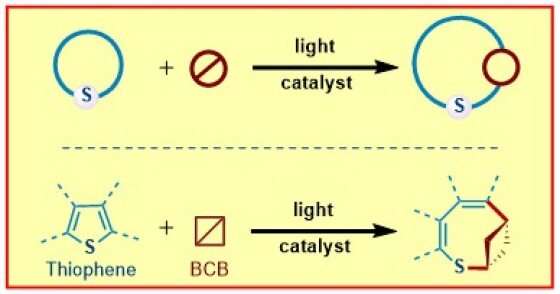This article has been reviewed according to Science X's editorial process and policies. Editors have highlighted the following attributes while ensuring the content's credibility:
fact-checked
peer-reviewed publication
trusted source
proofread
Chemists develop new process for the production of ring-shaped molecules

Most drugs on the market consist of cyclic (ring-shaped) molecules, many of which contain multiple rings. Developing simple and powerful methods for constructing important and novel ring systems remains a task and challenge for chemists in order to produce drugs more efficiently and also to enable new drug structure motifs.
An increasingly popular strategy is to modify ring systems by so-called structural editing. This involves slightly altering the scaffold of molecules at a late stage of synthesis, in much the same way that errors are corrected when proofreading a text.
An international team of chemists led by Professors Frank Glorius (University of Münster) and Kendall N. Houk (University of California, Los Angeles) has now succeeded for the first time in using this method to insert a four-membered molecular ring into a larger, aromatic ring, creating a structurally complex bicyclic ring system. The team published this new strategy in the journal Science.
"The change we achieved in the original ring system is amazing. The insertion of a ring into a ring could serve as a blueprint for further developments," says Frank Glorius. Dr. Huamin Wang, first author of the paper from the Münster group. "The simple and mild conditions also make this reaction promising for possible applications."
To perform structural editing, at least one chemical bond of the molecular backbone must be selectively cleaved. A modern tool that provides the necessary energy and selectivity is visible-light photocatalysis. The research team used what is known as photoredox catalysis.

This branch of photocatalysis uses the transfer of single electrons. In this process, the photocatalyst absorbs the energy of the light irradiation and "activates" the substrate by transferring an electron. "Activation" means that the substrate is made reactive. The use of visible light and photochemical activation allows the development of mild and simple reaction conditions.
In this case, the chemists used an important sulfur-containing molecule, thiophene, as a substrate. In the new process, the carbon-sulfur bond of the thiophene is cleaved eventually. The second reactant—a molecule consisting of a strained four-membered ring (bicyclobutane)—is inserted between the sulfur and carbon. The conversion is environmentally friendly and atom-economical, meaning that all the atoms of the two starting materials end up in the product.
The team uncovered the underlying mechanism of the new reaction through a close collaboration of experimental and computational chemistry. Frank Glorius' group performed a series of experimental studies to investigate the possible mechanism. In addition, Ken Houk and his group computationally modeled the reaction in detail.
In this way, they showed how these reactions occur and why they are highly selective. "Density Functional Theory calculations demonstrated that the photoinduced ring expansion mechanisms of thiophene and benzothiophene proceed via photoredox-induced radical-ion mechanisms," explains postdoc Dr. Huiling Shao.
More information: Huamin Wang et al, Dearomative ring expansion of thiophenes by bicyclobutane insertion, Science (2023). DOI: 10.1126/science.adh9737
Journal information: Science
Provided by University of Münster





















